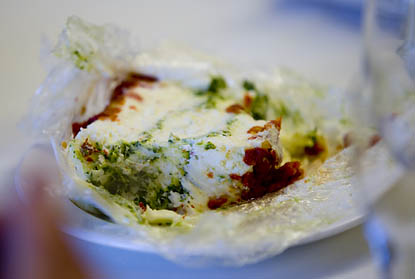Food in the Bates curriculum: A tasting menu

YOU EAT WHERE YOU ARE In her course “Back East, Down South, Out West: Regions in American Culture,” history professor Margaret Creighton looks at eating habits as part of a greater examination of regional identity. In the East, deep South and West, the course explores the intersection of demographic and economic history with cultural invention. Creighton’s readings include America Eats! by Pat Willard, a collection of experiences from writers of the Works Progress Administration who describe dining experiences from chitlin struts to squirrel hunts.
COOKING THE BOOKS The food narrative is an increasingly popular subgenre of autobiography. As Gourmet Magazine Editor-in-Chief Ruth Reichl explains, people nowadays are “writing their lives in food. They are actually looking at the world food-first.” Myron Beasley’snew Short Term course “Taste, Memory, Book: Indigestible Memories of Food” gives students a chance to savor the intersection of writing, memory and food by reading others’ and creating their own food books. Visiting assistant professor of African American studies and American cultural studies, Beasley frequently incorporates food into his courses.
EAT TO LIVE The course “Biology of World Health and Disease” takes two views of food, explains Pam Baker, Helen A. Papaioanou Professor of Biological Sciences. A section on noncommunicable disease focuses on heart disease and the effects of dietary fat. A section on nutrition in health and disease, meanwhile, examines the obesity crisis in the U.S. and elsewhere. “We also study how other medical systems, such as Ayurveda and traditional Chinese medicine, regard food as the key to a balanced — that is, healthy — life,” she says.
LE GUIDE CULINAIRE French Professor Mary Rice-DeFosse ensures that one of the world’s great cuisines is represented at Bates in her course “Introduction to Contemporary France,”which explores French society and culture and spends time on culinary customs, regional foods, food production and the role of food in French holidays. The curriculum includes Roland Barthes’ essay collection Mythologies, which examines the creation of modern myths — among them, the contemporary view of red wine as a French national drink and social equalizer.
TINY CHEFS Lecturer in Biology Karen Palin teaches the Short Term course “Microbes and Everyday Life,” an examination of the ubiquity and influence of microbes in our lives — including what we eat and drink. The proof is really in the pudding as the class enjoys a “microbial meal,” made up of foods that are either microbes themselves or the products of microbial activity. “The last time I taught this,” Palin says, “our meal included mushrooms — which are considered microbes — grilled Swiss cheese sandwiches on sourdough, yogurt that we made in class, pickles and locally fermented soda pop. We also has Cajun Ernie’s tea, a product of microbial biofilms, and a few brave folks even tasted the edible biofilm.”
PAST PRESENT A member each from the Spanish and English faculty will bring students to Spain in 2010 for the new Short Term course “The Medieval in Modern Spain,” which explores modern manifestations of the medieval through the literature, architecture, art and cinema of Spain. The course will spend time, and a few calories, on the foodways of Catalonia: “We’ll study — and sample! — recipes from a 14th-century Catalan cookbook,” notes Assistant Professor of EnglishSylvia Federico, who’ll teach the course with Visiting Assistant Professor of Spanish David George. They’ll also compare medieval and modern land use for food production, and think about how specific ingredients and cooking methods are integral to understanding cultural identity.